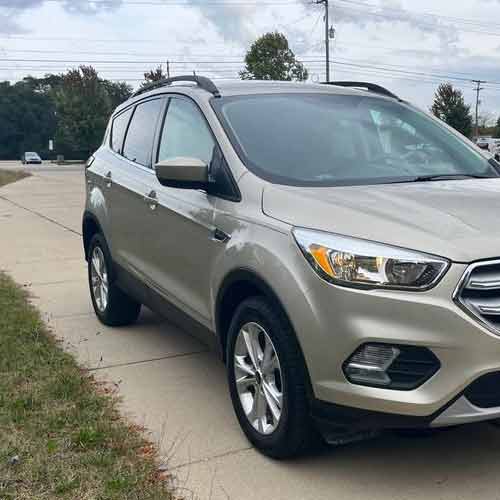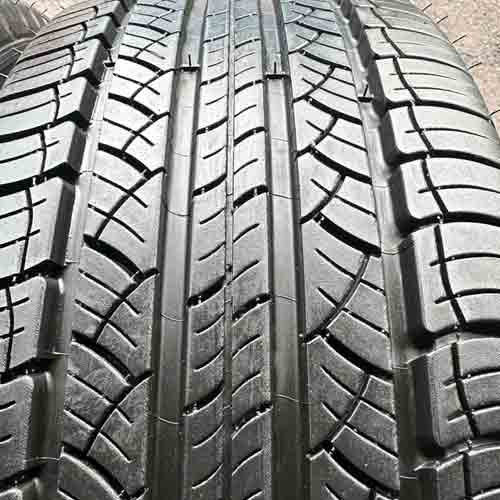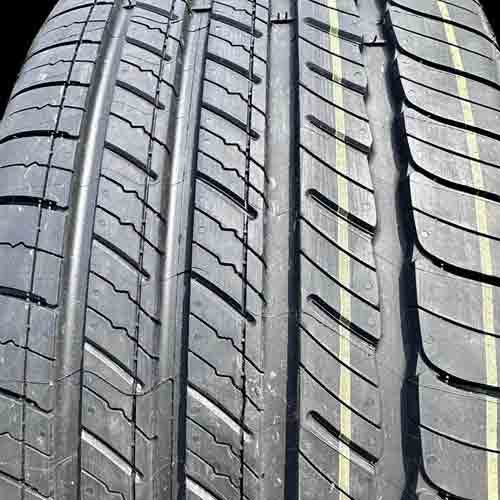Both of these are premier tire offerings from Michelin, catering to distinct vehicle segments. While the Latitude Tour HP is designed for family sedans and crossovers prioritizing comfort, the Primacy Tour AS serves the high-end crossover and SUV market, blending handling and all-season capability.

In a head-to-head comparison, the Michelin Primacy Tour AS excels in wet conditions and offers a quieter ride with longer tread life. Meanwhile, the Michelin Latitude Tour HP shines in dry handling. Also both tires turn out having equal scores in terms of fuel economy and winter traction.
Table of Contents
Tire Sizes
The Michelin Latitude Tour HP comes in 16 to 22 inches rims, and they have the following specs.
- Speed ratings: H, V, W, and Y.
- Load ratings: SL and XL.
- Tread depth range: 9 to 10/32″.
- Weight range: 27 to 43 lbs.
- Treadwear warranty: 55k miles for H and V rated sizes, and 45k for W, and Y speed rated ones.
- UTQG rating: 440 A B.
For Your Info: Most folk ask me, what’s the difference between the Latitude Tour and the Tour HP, well, they are very similar looking from the outside, but the “simple Latitude Tour” has lower speed rating, and greater tread depth (almost 2/32″ greater). And gives you greater mileage, and also the warranty, (which is 65k), with a UTQG of 720 A B.
Review the HP variant, in greater detail: https://tiredriver.com/michelin-latitude-tour-hp-review/
The Michelin Primacy Tour A/S comes in 17 to 22 inches rims. They all have the following specs.
- Speed ratings: H and V.
- Load ratings: SL and XL.
- Tread depth: 7 to 11/32″.
- Weight range: 25 to 37 lbs.
- Treadwear warranty: 55k miles for H and V, while 45k miles for W (speed rated) sizes.
- UTQG rating: 540 A A.
Review this tire in detail: https://tiredriver.com/michelin-primacy-tour-a-s-review/
External and Internal Construction
The Michelin Latitude Tour HP showcases a symmetric tread pattern, showcasing five ribs.

Now although all these ribs have similar tread features, there are still some differences to note.
Like for example, the central most rib is continuous running, and with its offset edges, it forms very tough passing circumferential grooves on either sides.
The adjacent ribs have interlinked in-groove notches, which also inter-connect the outer longitudinal channels.
And although the shoulder lugs are also characterized by similar wave like siping, and curved in-groove notches, they are more packed up.
I mean if you look closely you’d note that all these (shoulder) lugs are connected to each other by rubber ridges in between.
Internally, the tire comes with a single-ply polyester casing, flanked by two steel belts and a nylon cap ply.
On the other hand, the Michelin Primacy Tour A/S stands out with an asymmetric tread pattern.

Now, although its tread feature similar five-rib design, like its competitor, its less aggressive overall.
Examining from the right side of the image, the first two ribs display closely packed shoulder lugs with curved edges.
Notably, these lugs and in-groove notches mirror each other’s orientation.
They form a zigzag pattern with the adjacent rib, which, while also has curved siping, comes with thicker notches.
The subsequent two ribs bear a resemblance to each other, showcasing similar bite characteristics as the previous rib but with the added presence of interlocking siping and vertical slits on the lugs.
The far left shoulder, as seen in the image, holds interlocking sipes akin to its counterpart on the right, but other than that, it doesn’t deviate much from the design on the opposite end.
Internally, the structure comprises a two-ply polyester cord casing, accompanied by two steel belts and topped with a single-ply polyamide cap ply.
Overall Wet Performance
Effective wet performance in tires primarily revolves around how well they can displace water from the tread, ensuring a consistent rubber-to-road connection. This displacement is achieved through grooves and sipes.
Grooves handle the bulk of water displacement, helping resist hydroplaning. whereas sipes complement this, by taking care of any remaining water, providing necessary grip.
Now, regarding this grip, you should know that both tires aren’t really impressive here. However, among the two, the Michelin Primacy Tour AS still has the upper hand.
The tire possesses a superior siping structure and is made of a softer compound. The design allows sipes to effectively manage water better.
Sipes basically contract/expand to create suction for water particles coming underneath, so with softer compound, they absorb water particles more effectively, ensuring that the tire’s rubber components, like biters, maintain a better grip on relatively drier surfaces.
Moreover, Primacy Tour’s greater tread depth of 11/32″ is also helping here, as it facilitates the larger expulsion of water through its grooves, (relatively).
This not only enhances hydroplaning resistance but also means that there’s less water for the sipes to manage, in the first place.
On the flip side, the Michelin Latitude Tour HP lacks in overall wet traction, with its relatively rigid rubber compound and less efficient siping design.
Tread Life
When discussing tread longevity, the Michelin Latitude Tour HP although offers a very durable silica-based tread, its overall tread life is still falling a bit short compared to its counterpart.
And this can be clearly seen by their UTQG (Uniform Tire Quality Grading) ratings.
Now, its essential to note that the UTQG rating isn’t particularly useful when comparing tires from different manufacturers. Though at the same time, it becomes a significant comparison tool when evaluating tires from the same brand.
I mean looking at both Michelin tires, it can be clearly seen that the Primacy Tour with a treadwear rating of 540, means that it lasts 5 times longer compared to the reference tire, whereas the Latitude Tour HP with rating of 440, only lasts 4 times as long (again compared to the reference tire).
So what gives Primacy Tour AS the upper hand here?
Well, the tire is lighter in weight, so its rubber undergoes less overall rolling resistance (with less weight pressure on lugs, as they rub against the road).
Moreover, it also features greater tread depth, meaning it takes longer to wear down to the minimum legal tread depth of 2/32″ in the US.
Road Noise
Noise is just air particles (entering in the tread through shoulder voids), and hitting the walls around.
And here, the Michelin Primacy Tour AS offers a quieter design.
The tire features ridges between its shoulder lugs, which significantly restrict the influx of air, addressing noise at its origin.
Furthermore, its tread contains polymers which are more adept at absorbing noise waves, preventing them from amplifying and causing in-groove resonance.
On the other hand, the Michelin Latitude Tour with more open shoulders, produces greater noise, where its numerous wave-like sipes also further add to that, creating additional growling sounds.
Nonetheless, given the tire’s overall grip, this noise level still remains acceptable. And that is aided mainly by the tire’s variable pitch tread, which emits a variety of sound frequencies to ensure the noise doesn’t intensify excessively.
Dry Performance
When analyzing dry performance, the primary considerations are directional grip and handling. Let’s get in to them.
Directional Grip
Directional grip essentially measures a tire’s braking efficiency, which is influenced significantly by the it’s rubber-to-road contact and its weight.
And considering these factors, it can be seen why the Primacy Tour AS slightly edges out its competition, offering slightly superior braking efficacy.
So why is that? Well the reasons for this advantage are twofold:
- The Primacy Tour HP has fewer tread features, meaning there’s less interruption in rubber-to-road contact. Simply put, fewer features mean more direct rubber contact with the road.
- The tire’s lighter construction contributes to smaller inertia when braking, enhancing its overall stopping power.
Now I want to be clear here, that the difference between the two tires is really low, I mean its less than a mere foot.
And Michelin Latitude Tour HP by no means is bad here. In fact its quite the contrary, where its distinctive angular notches (the in-groove biters visible on the tire), offer more than enough overall directional grip.
Its just that in this particular performance metric, it’s slightly lacking compared to Primacy Tour A/S.
Dry Handling
The overall handling of a tire is a combination of its lateral traction with its steering response.
And here, the Michelin Latitude Tour HP is taking the lead.
I mean although both tires exhibit comparable lateral traction values, as evidenced by their similar lateral g-forces, the Latitude Tour still takes the lead, showing up with faster handling, due to its more communicative steering.
This is due to the tire’s enhanced stability, courtesy of its spirally-wound nylon cords, (housed internally).
And when this paired with the tire’s notable lateral traction, the Latitude Tour HP consistently records some of the quickest dry lap times, as demonstrated in tests, relative to other tires in its category, and not just the Primacy Tour.
So why is that happening?
Basically with a stiffer rubber, and spirally wound cap plies, the Latitude Tour HP minimizes its lug flexing. This is significant as its tread doesn’t waste time returning to its original shape, which in turn improves the tire’s balance during both understeering and oversteering.
Fuel Usage
Various factors influence fuel economy, where some of the most significant ones, include the tire’s weight, tread depth, and composition, all of which affect its rolling resistance directly.
Now here, the Michelin Latitude Tour HP with its stiffer rubber composition, coupled with an optimal tread depth and reinforced support for all lugs, undergoes minimal lug flexing.
And since lug flexing consumes energy to reshape the tread, the tire effectively channels its energy towards propulsion, leading to commendable fuel efficiency.
But its overall fuel economy is similar to Primacy Tour AS, which although has a softer compound, offers a lighter construction, so there’s reduced pressure on the lugs during their interaction with the road.
And this again minimizes the rolling resistance generation, ensuring that the tire’s fuel economy remains largely un-compromised.
So overall both tires are great here, and you can’t really put one over the other, as they both give out similar MPGs.
So What’s The Verdict?
Both tires have their unique strengths.
The Michelin Latitude Tour HP impresses with handling in dry conditions, attributed to its firmer composition and internal nylon cords, while its competitor excels in wet conditions due to superior siping and water management.
Moving towards other performance metrics, the Michelin Primacy Tour AS offers a longer lasting tread, due to its lighter weight and deeper tread, where it also offers a slightly quieter ride as well.
Though both tires have similar fuel efficiencies.
Interesting comparisons — thanks!
Just now coming off Latitude Tour HP and looking for another similar but improved replacement in the same brand of Michelin on my low mileage 2010 Lexus RX350 AWD. From the get-go I found the Latitude mostly great touring tires (second set). But with some serious limitations namely, poor cold weather performance, especially dangerous in PNW icy road intersections — almost got clobbered once. But surprisingly good in a little wet snow.
Another is that the all-performance features seem to fall off a cliff at around 25k miles — even with 6/32″ remaining. This includes high speed instability and way more road noise. Yes, pressures are checked and they have been rotated about every 5k miles.
It’s all annoying on a normally quiet car.
Thus I’m looking for replacements. Probably from Costco, due to their transparent policies.
Perhaps the Primacy Tour will fill the bill?
How about Defender 2 — does it compare favorably?
The Michelin Primacy Tour offers a quiet and comfortable ride with good all-season performance. The Defender 2 provides excellent durability and improved cold weather handling. Both are solid choices for your needs.
After all these months of waffling back and forth, I decided to just swap out the new Defender2 and go back to the Latitudes, as they are a known entity to me. The D2 were way too stiff riding for our AWD Lexus — felt every rut and bump in the road. They pretty much equated to what the OEM Lats felt like near the end of their lives.
The Primacy Tour were never auditioned.